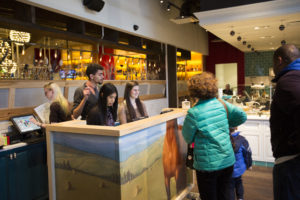As restaurant owners and operators sift through the growing number of Point of Sale (POS) options for their restaurant and hospitality businesses, it’s our job to help clients pinpoint the one that checks of the boxes that speak to their specific, functional, daily needs.
We forecasted bar and restaurant POS systems to be at the forefront of the tectonic shifts and challenges facing our industry this year, and almost three months in, our team is digging into this important industry topic. “With all of the new cloud-based systems on the market,” says our Managing Partner & Vice President of Restaurant Operations, Amber Hartman, “I’m finding that clients are really overwhelmed when deciding on what to look for in a bar and restaurant POS system and determining how to select one based on their needs.”

Below, Amber delves in. Outlining what operators need to look for in POS software & systems, analyzing their day-to-day needs, and finding the right fit.
- Pricing. Every restaurant is different, so choosing a restaurant POS system that provides the greatest value to the business is vital. Amber has seen it all: small restaurants splurging on robust, expensive systems, such as Aloha or Micros, that they don’t really need; and on the flipside, operators trying to save on their systems budget line and implementing a restaurant POS that can’t accommodate all their needs only to quickly realize that they got what they paid for. The bottom line: Take the time to choose a system that offers straightforward transparency in pricing (aka no hidden costs) with optional, versus mandatory, contract specs.
- Reporting/Features. Owners should realistically assess their needs, making sure the restaurant POS system they choose checks all the feature boxes they utilize regularly, with room to grow/alter over time (hence, entering into a POS agreement with optional contract specs). Amber suggests looking for a streamlined, cloud-based restaurant POS system that offers capabilities to fit ones needs, such as: product mix and inventory reporting, labor and performance management, remote sales check capabilities, ability to sell (and process) gift cards, a fluid order tracking system, and the like.
- Integration. Is key. Making sure a restaurant POS system in question integrates well with the other software in use (and vice-versa) is crucial for success. For example, Amber says, “If your restaurant uses QuickBooks for accounting and Hot Schedules for labor management, make sure the restaurant POS system you are looking at is compatible with those platforms.”
- Support. Make sure support is available 24/7. Amber has guided clients on one coast in purchasing a new restaurant POS system for their business because the POS company of the one they were using was based on the opposite coast… offering only weekday, business hours support within their time zone. Not optimal when you are running a business.
- Usability. Choosing a system that is intuitive, streamlined, and straightforward will allow for the team to be set up for success. In such a fast-paced environment, overly complicated systems can become quite cumbersome for any restaurant team and complicate not only the training process, but also day-to-day systems and data operations.
